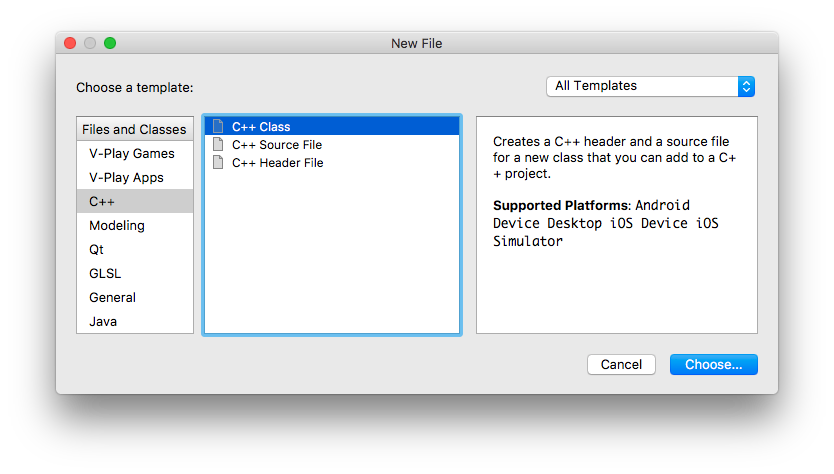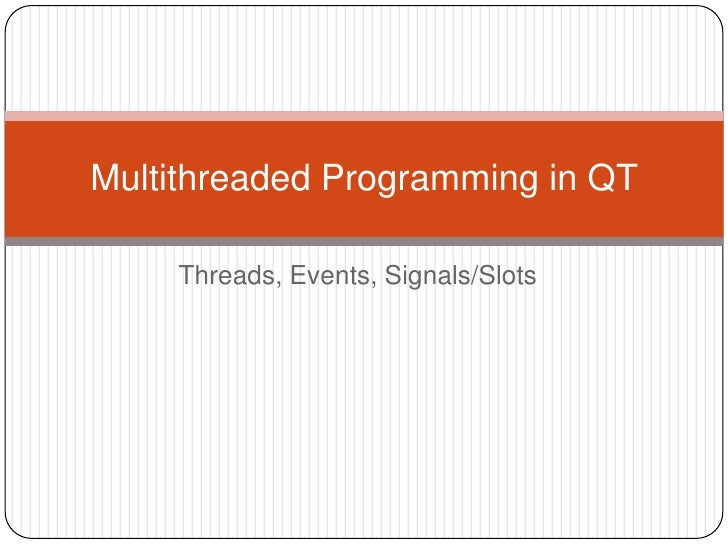The Custom Type example shows how to integrate a custom type into Qt's meta-object system.
Contents:
Qt Slots And Signals Threads, online poker real money usa legal mac, manga kong blackjack, free wild cougar slot machine. Read our full review. The thread that delivers the event will release the semaphore right after the slot has been called. Meanwhile, the thread that called the signal will acquire the semaphore in order to wait until the event is processed. Signals and slots are used for communication between objects. The signals and slots mechanism is a central feature of Qt and probably the part that differs most from the features provided by other frameworks. Signals and slots are made possible by Qt's meta-object system. Qt documentation states that signals and slots can be direct, queued and auto. It also stated that if object that owns slot ‘lives' in a thread different from object that owns signal, emitting such signal will be like posting message – signal emit will return instantly and slot method will be called in target thread's event loop.
Thread-Safe Signals/Slots using C11 Qt Signals and slot thread safety CODE Q&A English It depends on connection type you specified via calling connect function.Does anyone have an connect, qthread, signal, slot,thread,context,movetothread,created,param,call,threads,supply,object,specifically,executed,slot,wrote,qthread Thread.
Overview
Qt provides a range of standard value types that are used to provide rich and meaningful APIs. These types are integrated with the meta-object system, enabling them to be stored in QVariant objects, written out in debugging information and sent between components in signal-slot communication.
Custom types can also be integrated with the meta-object system as long as they are written to conform to some simple guidelines. In this example, we introduce a simple Message class, we describe how we make it work with QVariant, and we show how it can be extended to generate a printable representation of itself for use in debugging output.
The Message Class Definition
The Message class is a simple value class that contains two pieces of information (a QString and a QStringList), each of which can be read using trivial getter functions:
The default constructor, copy constructor and destructor are all required, and must be public, if the type is to be integrated into the meta-object system. Other than this, we are free to implement whatever we need to make the type do what we want, so we also include a constructor that lets us set the type's data members.
To enable the type to be used with QVariant, we declare it using the Q_DECLARE_METATYPE() macro:
We do not need to write any additional code to accompany this macro.
Qt Signals And Slots Tutorial

To allow us to see a readable description of each Message object when it is sent to the debug output stream, we define a streaming operator:
This facility is useful if you need to insert tracing statements in your code for debugging purposes.
The Message Class Implementation
The streaming operator is implemented in the following way:

Here, we want to represent each value depending on how many lines are stored in the message body. We stream text to the QDebug object passed to the operator and return the QDebug object obtained from its maybeSpace() member function; this is described in more detail in the Creating Custom Qt Types document.


We include the code for the getter functions for completeness:

To allow us to see a readable description of each Message object when it is sent to the debug output stream, we define a streaming operator:
This facility is useful if you need to insert tracing statements in your code for debugging purposes.
The Message Class Implementation
The streaming operator is implemented in the following way:
Here, we want to represent each value depending on how many lines are stored in the message body. We stream text to the QDebug object passed to the operator and return the QDebug object obtained from its maybeSpace() member function; this is described in more detail in the Creating Custom Qt Types document.
We include the code for the getter functions for completeness:
With the type fully defined, implemented, and integrated with the meta-object system, we can now use it.
Using the Message
In the example's main() function, we show how a Message object can be printed to the console by sending it to the debug stream:
You can use the type with QVariant in exactly the same way as you would use standard Qt value types. Here's how to store a value using the QVariant::setValue() function:
Alternatively, the QVariant::fromValue() function can be used if you are using a compiler without support for member template functions.
Qt Signal Slot Not Working
The value can be retrieved using the QVariant::value() member template function:
Further Reading
The custom Message type can also be used with direct signal-slot connections.
To register a custom type for use with queued signals and slots, such as those used in cross-thread communication, see the Queued Custom Type Example.
More information on using custom types with Qt can be found in the Creating Custom Qt Types document.
Qt Signal Slot Cross Thread Holders
© 2020 The Qt Company Ltd. Documentation contributions included herein are the copyrights of their respective owners. The documentation provided herein is licensed under the terms of the GNU Free Documentation License version 1.3 as published by the Free Software Foundation. Qt and respective logos are trademarks of The Qt Company Ltd. in Finland and/or other countries worldwide. All other trademarks are property of their respective owners.